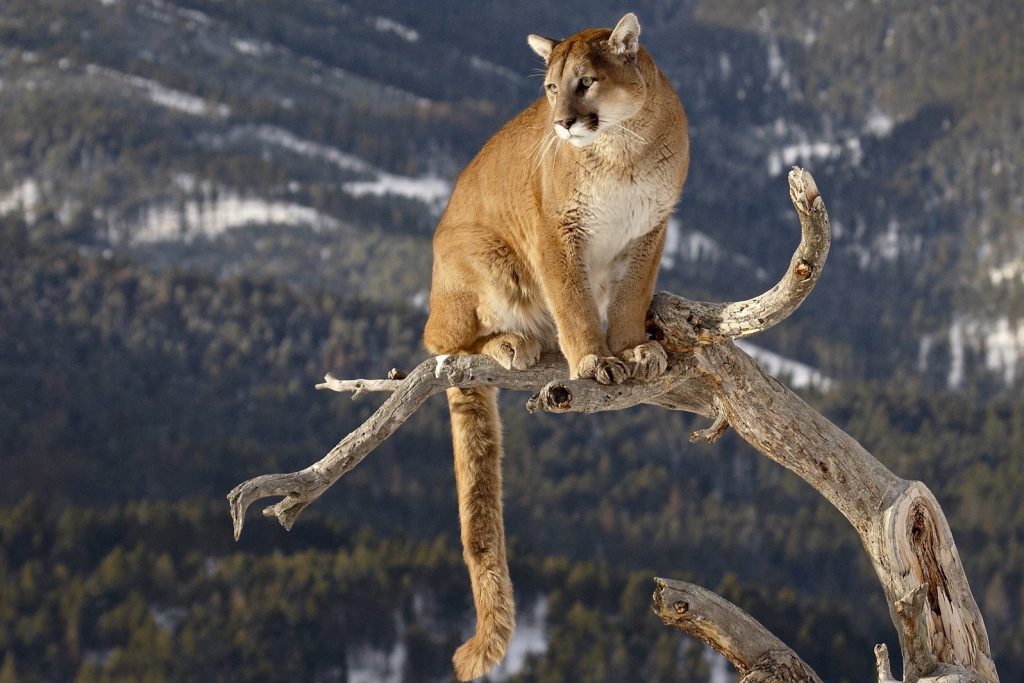The Mountain Lion (Puma concolor), also known as the cougar, puma, or panther, lives in the Western Hemisphere, ranging from the Canadian Yukon to the Argentine Andes. With an estimated population of 300,000 in North America, these big cats can be found from British Columbia to Texas. Small populations may also inhabit isolated pockets east of the Mississippi River with the endangered Florida panther, numbering less than 1,000, located in southwestern Florida.
Mountain lions were hunted out of existence in most of the Eastern United States, although there are unconfirmed reports of sightings in the Midwest and as far east as Connecticut.
The mountain lion is territorial and avoids other cougars, except during courtship. Adults have territories ranging from 10 square miles to 375 square miles.
Most mountain lions are about the size of a German Shepherd, ranging from 5-8 feet long and weighing between 60-180 pounds. Its fur is typically tan or reddish brown with only the juvenile lions having spots.
In a single leap, the mountain lion can bound 40 feet horizontally and up to 20 feet vertically. Their long thick tail helps with balance when leaping and climbing. The big cat has an average walking speed of 10 mph and can sprint up to 50 mph.
The mountain lion hunts a wide variety of prey with its primary food sources being deer, rodents, raccoons, feral hogs, and the occasional mountain biker or hiker. Early mornings and evenings are the preferred hunting times.
The mountain lion’s hunting tactic is ambushing from above and attacking from behind. The lion will stalk its prey or wait patiently in thick cover or rock crevices for an animal to approach. Once the prey is within 50 feet, the mountain lion sprints, or pounces, taking it by surprise.
After killing its prey, the mountain lion will bury it with sticks, dirt, leaves, or other debris. A lion with a large territory may make several kills and cache the food throughout its range as it patrols and defends its turf.
The mountain lion’s mating season is typically from December to March with the gestation period lasting 82-96 days. Females will have 2-4 kittens which the mother raises by herself, teaching them how to hunt after they weaned. The juvenile lions will stay with their mother for 18-24 months.
The mountain lion lives up to 13 years in the wild and can live over 20 years in captivity.
To the indigenous tribes in North America, the mountain lion held a variety of personas. The Algonquin believed the mountain lion was evil and lived in the underworld while the Cherokee sang a sacred song to the predator as a means of healing frostbitten feet. Across the continent, the Apache considered the cougar’s wail as the signal of impending death.
Mountain lions are highly adaptable and still manage to survive and find wild pockets to live in among the sprawl of Los Angeles. They have been known to cross freeways and travel along interconnected canyons so it is possible you might see one along a hiking trail in an otherwise urban area.
Although mountain lion attacks on humans are rare, it’s still helpful to be able to recognize the signs that you are in cougar country. The easiest indicator to find is a mountain lion’s kill site. This will most likely be a deer partially covered by debris and tucked into a remote area. The mountain lion will use this cache for up to 10 days so if you see one, stay alert.
Mountain lion attacks are most frequent during late spring and summer when the juveniles leave their mothers and begin the search for their own territory. Due to their size and herky-jerky running gait, children and small dogs are at the highest risk of a mountain lion attack. They are also the least likely to survive. When hiking through mountain lion country, keep your young ones close and your dogs on a leash.
Mountain lion tracks are about four inches wide and show a distinctive “M”-shaped pad with four toes and a three-lobed rear heel. For reference, dogs have four toes and two lobes. A lion’s claw marks do not show in the track. If you see more than one track look for an overstepping trail where the lion’s back foot steps in the front foot track, creating an overlapping pattern.
If you are lucky enough to see a mountain lion, this is not the time to be timid and respectful. Maintain your distance. Do not approach the animal and make sure it has a way to escape as most mountain lions would rather avoid a confrontation. Don’t run, play dead, or even stand still like you would with the American Black Bear. This may stimulate the lion’s prey drive. Instead, channel your inner obnoxiousness. Make intense eye contact, shout, and wave your arms so you appear more menacing and bigger than you are.
If the mountain lion isn’t buying your act, calls your bluff, and decides to attack, now is the time to move that inner toggle switch from obnoxious to badass. Fight back using your fists, feet, rocks, sticks…or even wield that $3,000 mountain bike as a carbon fiber battle axe. Do anything in your power to discourage the mountain lion and make it pick an easier meal elsewhere.
Though strong and seemingly fearsome, these big cats want the same things we want to live free and wild and not bothered by anyone else.
